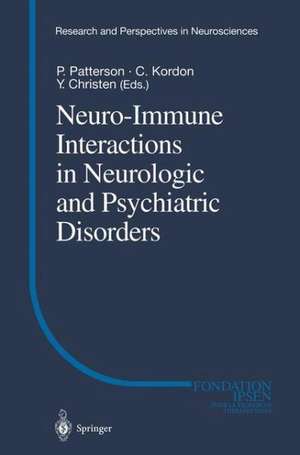Neuro-Immune Interactions in Neurologic and Psychiatric Disorders: Research and Perspectives in Neurosciences
Editat de P. Patterson, C. Kordon, Y. Christenen Limba Engleză Paperback – 19 sep 2011
Din seria Research and Perspectives in Neurosciences
- 18%
 Preț: 944.99 lei
Preț: 944.99 lei - 18%
 Preț: 938.83 lei
Preț: 938.83 lei - 18%
 Preț: 941.68 lei
Preț: 941.68 lei - 18%
 Preț: 1218.21 lei
Preț: 1218.21 lei - 18%
 Preț: 945.92 lei
Preț: 945.92 lei - 5%
 Preț: 1403.44 lei
Preț: 1403.44 lei - 18%
 Preț: 1215.70 lei
Preț: 1215.70 lei - 5%
 Preț: 711.72 lei
Preț: 711.72 lei - 18%
 Preț: 944.36 lei
Preț: 944.36 lei - 18%
 Preț: 936.95 lei
Preț: 936.95 lei - 18%
 Preț: 944.19 lei
Preț: 944.19 lei - 15%
 Preț: 638.89 lei
Preț: 638.89 lei - 18%
 Preț: 945.62 lei
Preț: 945.62 lei - 15%
 Preț: 636.63 lei
Preț: 636.63 lei - 18%
 Preț: 886.62 lei
Preț: 886.62 lei - 15%
 Preț: 635.47 lei
Preț: 635.47 lei - 15%
 Preț: 636.30 lei
Preț: 636.30 lei - 15%
 Preț: 635.65 lei
Preț: 635.65 lei - 15%
 Preț: 636.12 lei
Preț: 636.12 lei - 24%
 Preț: 734.67 lei
Preț: 734.67 lei -
 Preț: 422.31 lei
Preț: 422.31 lei - 5%
 Preț: 517.17 lei
Preț: 517.17 lei - 18%
 Preț: 937.41 lei
Preț: 937.41 lei
Preț: 636.63 lei
Preț vechi: 748.97 lei
-15% Nou
Puncte Express: 955
Preț estimativ în valută:
121.82€ • 127.19$ • 100.82£
121.82€ • 127.19$ • 100.82£
Carte tipărită la comandă
Livrare economică 04-18 aprilie
Preluare comenzi: 021 569.72.76
Specificații
ISBN-13: 9783642640650
ISBN-10: 3642640656
Pagini: 220
Ilustrații: XIV, 204 p. 6 illus. in color.
Dimensiuni: 155 x 235 x 12 mm
Greutate: 0.31 kg
Ediția:Softcover reprint of the original 1st ed. 2000
Editura: Springer Berlin, Heidelberg
Colecția Springer
Seria Research and Perspectives in Neurosciences
Locul publicării:Berlin, Heidelberg, Germany
ISBN-10: 3642640656
Pagini: 220
Ilustrații: XIV, 204 p. 6 illus. in color.
Dimensiuni: 155 x 235 x 12 mm
Greutate: 0.31 kg
Ediția:Softcover reprint of the original 1st ed. 2000
Editura: Springer Berlin, Heidelberg
Colecția Springer
Seria Research and Perspectives in Neurosciences
Locul publicării:Berlin, Heidelberg, Germany
Public țintă
ResearchCuprins
Organization of Inflammatory Processes in Alzheimer’s Disease.- Glial Cytokines in Neurodegenerative Conditions.- Contributions of the Glial Injury Response to the Multifactorial Pathogenesis of Alzheimer’s Disease.- Cytokine Communication Between Neurons and Glia and the Pathogenesis of Alzheimer’s Disease.- Glial Hyperactivity During Aging as a Neuroinflammatory Process.- Mechanistic and Metaphorical Connections Between NF-KB and the Secreted Alzheimer’s ?-Amyloid Precursor Protein.- Pathological and Biochemical Studies of Chronic Neuroinflammation May Lead to Therapies for Alzheimer’s Disease.- Serotonine-Immune Interactions in Major Depression.- Responses in the Raphe-Hippocampal Serotonergic System During Peripheral Inflammation: Putative Role in Sickness Behaviour.- Neuronal Control of the Immune Response in the Central Nervous System: From Pathogenesis to Therapy.- Regulation of Cyclic AMP Synthesis in Microglial Cells and Possible Role of Cyclic AMP in Neuroprotection.- Cytokine and Anti-Inflammatory Drug Effects on Brain Trauma and Alzheimer’s Disease Pathology in Transgenic Mice.- In vivo Involvement of the Cytokine LIF During Lesion-Induced Renewal of Olfactory Sensory Neurons in Adult Mouse.- Neuroglial Activation in the Nervous System Following Injury: Role of Cytokines.- Sickness Behavior: A Neuroimmune-Based Response to Infectious Disease.- Central Origin of IL-1? Produced During Peripheral Inflammation: Role of Meninges.- Vitamin D, a Hormone Involved in the Control of Neuro-immune Interactions in the Brain.
Textul de pe ultima copertă
This book arrives at the moment when the role of inflammatory processes in neurodegenerative disease, mental illness, and injury is starting to become more widely appreciated. As summarized in these chapters from some of the major laboratories in the field, not only can the brain interact actively with the immune system, but it can generate its own inflammatory responses to stress, certain diseases, and other insults. The contribution of cytokines and other inflammatory molecules to Alzheimer's disease is highlighted here, as is the key importance of the brains's own inflammatory cells, the microglia. Such studies in cell culture and in animal models clearly have the potential to influence clinical practice. The two-way communication between the brain and the immune system is emphasized by experiments showing that infection in peripheral tissues can cause dramatic changes in behavior of animals, while behavioral states such as severe depression can induce marked changes in immune function. These molecular and anatomical bases for such interactions are becoming understood, which will ultimately have therapeutic implications.
Caracteristici
Includes supplementary material: sn.pub/extras















